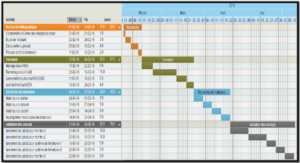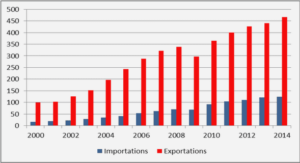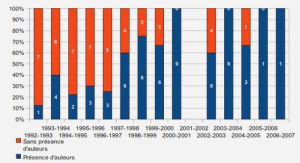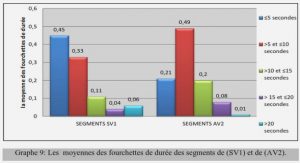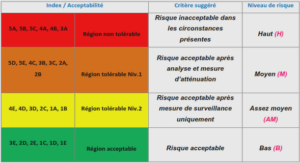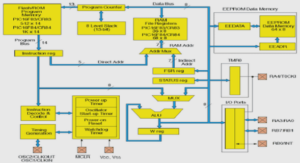• Market makers: they are liquidity providers. Tipically high-frequency agents, they post passive orders at the buy and sell side, then, they wait for other participants of the market to come and take their orders. As their name implies, they make the market by intermediating between slower buyers and sellers that would not be able to meet on the market at the same time. Essential to markets’ ecology, some of them are paid by the exchange to ensure sufficient liquidity. Otherwise, they make money from the difference between their buying and selling quotes and are then very profitable when the price is mean-reverting. Their risk comes mainly from their inventory: if the price trends in the opposite direction of their position they lose a lot of money. They therefore adjust their price quotations to manage their risk as well as possible. The capacity of their strategies is low, but they trade very frequently, which makes them profitable on average.
• Long investors: they take a position on the market and re-balance their portfolio from time to time. The time horizon of their strategy is very long, around several years, and their assets under management are huge. Thus, it can take them days to buy/sell their market positions. Because of the long time horizon, executing their transactions does not require sophisticated optimization techniques. They can use different types of strategies (momentum, ETF, fundamental etc.). They are usually institutional investors or pension fund managers.
• Brokers: they give an access to the market to those who cannot. Their clients cannot trade themselves on the market due to a technological gap, nor the best strategy to execute large orders. Their goal is to minimize the transactions costs by splitting smartly the orders of their clients.
• Banks: they oer derivative products, that we can interpret as insurance contracts, to their clients and manage their risks. They have teams working on elaborating such products that will suit the needs of their clients. Nevertheless, they can also have teams that do market-making, long term investment and brokerage.
• Other participants: other participants can play in between all the possible strategies, on both short or long time scale. Although technological advances have reshaped the market by providing new opportunities,the way agents trade and strategies are much the same. We can therefore say that this classication is stable over time. In what follows, we will keep in mind that market participants are highly heterogeneous. Electronic markets and the limit order book Historically, agents were physically present in the stock exchange. Such vivid scenes were well described by Emile Zola in his novel « L’Argent ». Some movies also represent the market at this stage, in the « Wolf of Wall Street » of Martin Scorsese for example. As previously mentionned, the emergence of new technologies have deeply reshaped the markets. First,the market switched to Over The Counter (OTC) markets where people negotiated products via telephones. Then, the development of the internet enabled news possibilities: trading on fully electronic markets. These markets are managed by a computer that matches the orders of agents, under systematic rules. Even though some OTC markets remain, the majority are electronic nowadays. Electronic markets are believed to be an optimal setting to allow fair access to the market. It aims at a better spread of the information to everyone and reduces insider trading. On the other hand, all the trades and intentions of trades of agents are stored and the regulation uses this data to detect frauds and illegal actions. Market regulators are therefore encouraging platforms to upgrade to such automated operation. From our point of view, electronic markets have made it possible to record an incredible amount of data. By dissecting this real treasure, we have the opportunity to understand the functioning of markets in detail. Since 2007, the emergence of Multilateral Trading Facilities has enabled agents to buy the same contracts on dierent electronic exchanges. Since then, electronic markets have become fragmented. We can cite « Chi-X » or « Turquoise » as competitors of the classical exchanges Euronext, NYSE, LSE etc. Oering dierent types of fees, their creation was made to reduce trading costs for market participants. From our perspective, it may complicate our modeling as we are interested in the aggregated market. By aggregate, we mean the sum of what happens on all the exchanges where we can buy the same asset. Nevertheless, we first need to understand what electronic markets are all about. We chose to focus on a particular type of electronic markets: a double auction one. It offers the possibility for an agent to trade passively or aggressively. With the first option, an agent can post a buy or sell order, which consists in a number of shares at a given price and wait for a counterpart. This passive order is called a limit order. Agents can cancel their passive orders if no counterpart has yet been found. The second option, called a market order, consists of matching an existing limit order. All these limit orders are stored in the limit order book. A schematic describing it is displayed on Fig. 1.1. It represents the interaction between supply and demand on nancial markets, essential to understand the price formation process. We refer to bid (resp. ask) side for the buy (resp. sell) side in the following. An important notion emerges from the order book: the liquidity. It refers to the quantity of shares available in the order book at a given time. Thus, posting a limit order in the limit order book provides liquidity while posting a market order takes liquidity. Note that some exchanges provide to their clients other fancy types of orders. More difficult to model, we restrict ourselves to exchanges and assets where only these three orders are available. Concerning market fragmentation, we assume that either we have access to the aggregated order book and if not that, the one we have is representative of the aggregated one.
|
Table des matières
Foreword
Chapter 1 Introduction
1.1 Financial markets & liquidity crises
Market participants
Electronic markets and the limit order book
Why study financial crises?
1.2 What drives price and volatility?
First draft of price models
Anomalous price returns: exogenous or endogenous?
Self-excited models for price dynamics
Zumbach effect and Q-Hawkes process
Market impact: how much do I move the price when I buy/sell?
1.3 Modeling the order book
A discrete model: the Santa Fe model
A continuous model: Latent Limit Order Book (LLOB)
1.4 Objectives of the manuscript
Chapter 2 Empirical evidence of price feedback
2.1 Introduction
2.2 Destabilizing Feedback Effects: Empirical Analysis
Order Book Data
Average Event Rates
A state dependent Generalized Q-Hawkes model
Calibration Strategy in a Minimal Setting
Results
2.3 Brute Force Calibration of a GQ-Hawkes Process
Definition of the Model
A Non-Parametric Calibration Procedure
Empirical Results
2.4 A Simplified Framework of a GQ-Hawkes Process
Effective Kernels
The Zumbach Factorisation
2.5 Liquidity Dynamics & Crises
Quadratic Feedback on Liquidity
Spread Dynamics and Liquidity Crises
2.6 Conclusion
Chapter 3 A Quadratic Santa Fe Model
3.1 Introduction
3.2 An Agent-Based Model for Liquidity Crises
The Santa Fe Model with Feedback
Numerical Simulations
Dynamics: stability or liquidity crises
3.3 Phase Transition and Finite Size Scaling
3.4 A scenario for liquidity crises
3.5 Conclusion
Chapter 4 Spread models: from Hawkes dynamics to metastable dynamics
4.1 Introduction
4.2 A State-Dependent Hawkes Model for Spread Dynamics
A Simple Model
The Stable Regime
Linear Spread Growth
The Explosive Regime
A Stabilizing Mechanism
4.3 A Model with Price Feedback on the Spread
4.4 Non-Linear Hawkes Models and Metastability
A Model with Quadratic Feedback
A Continuous Time Description
4.5 Conclusion
Chapter 5 Revealing liquidity in the latent order book
5.1 Introduction
5.2 A mechanism for latent liquidity revealing
5.3 Stationary order books
Analytical and numerical solutions
The LLOB limit
Numerical simulation
5.4 Market stability and calibration to real data
Market stability
Order book data
5.5 Price impact
5.6 Concluding remarks
Conclusion and future research
Appendices
Appendix A Technical details and additional results
A.1 Appendix of Chapter 2
Empirical Data and minimal setting calibration
GQ-Hawkes Estimation procedure
Low rank approximation
Additional plots and tables
A.2 Appendix of Chapter 3
Finite Size Scaling Method
Asymptotic properties of the Quadratic Santa Fe Model
A condition of transition when µ = 0
A.3 Appendix of Chapter 4
More on the Linear Spread Model
More on the Stabilizing Mechanism
More on the Model with Price Feedback on the Spread
Metastability some analytical results
A.4 Appendix of Chapter 5
A trick for computing stationary order books
Plots and ts of US stocks
Appendix B By Force of Habit: Self-Trapping in a Dynamical Utility Landscape
B.1 Introduction
B.2 A Simple model
B.3 Non-Ergodicity & Condensation of Choices
B.4 Mean Field Approximation
B.5 Numerical results
B.6 Aging
B.7 Conclusion
Appendix C Schrödinger’s ants: A continuous description of Kirman’s recruitment model
C.1 Introduction
C.2 Master Equation
C.3 Continuous description and Fokker-Planck equation
C.4 Schrödinger’s equation and general solution
C.5 Relaxation towards the stationary state
C.6 Conclusion
Appendix C.A Derivation of the Fokker-Planck equation and stationary solution
Appendix C.B Change of variables under an SDE
Appendix C.C Schrödinger from Fokker-Planck
Appendix C.D Properties of the solution
Checking the boundary condition
Explicit expressions
Computing the moments of the distribution
Appendix C.E Stochastic calculus techniques
Appendix D From Ants to Fishing Vessels: A Simple Model for Herding and Exploitation of Finite Resources
D.1 Introduction
D.2 Empirical shing data
Description of the data
Dening shing areas
Stylized facts
D.3 A Simple Model
D.4 Mean-eld approximation
Stationary solutions
Dynamics and correlation functions
D.5 The Symmetric Limit
D.6 Conclusion
Appendix D.A Full dynamical solution
Appendix D.B A symmetric multizones extension
Bibliography
![]() Télécharger le rapport complet
Télécharger le rapport complet

